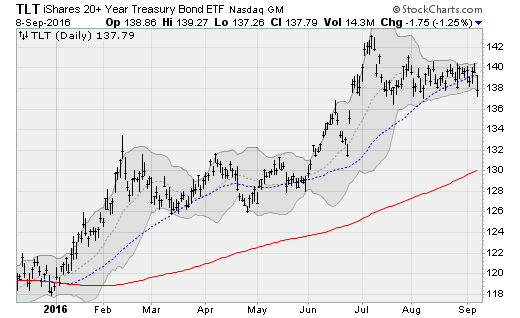How bond market pressure is slamming stocks
U.S. equities suffered their worst sell-off in seven months on Friday as long-term government bonds around the world are getting hit hard. The Dow Jones industrials index lost 2.1 percent as it closes back in on the 18,000 level from above -- tumbling out of an ultra-tight three-month trading range. This volatility ends a long quiet period in the market and further raises the stakes for the Federal Reserve policy meeting later this month.
The catalyst? Big-time selling pressure against long-term government bonds around the world.
Why does this matter to stocks? Well, that will take some explaining.
The move in long-term government bonds started on Thursday (chart below) after the European Central Bank left policy on hold amid rumors of a possible move to start purchasing equities and saying it didn’t consider lengthening or expanding its bond purchase program. This was more hawkish than expected.
The bond market pressure was cranked up by ongoing rate-hike chatter from Fed officials despite a clear slowdown in U.S. economic data, as bond traders pushed up the odds of a September rate hike to 24 percent from 18 percent previously. Dallas Fed President Robert Kaplan on Friday said the case for rate increases has strengthened in the last several months, although he said he saw no urgency to do so.
And the Bank of Japan capped it all off with indications it could cut short-term interest rates deeper into negative territory on Sept. 21 in combination with an effort to lift long-term rates to ease the pressure on retirement accounts and savers.
This would amount to a “reverse Operation Twist” -- alluding to the Fed’s efforts in 1961 and 2011 to change the relationship between short-term and long-term interest rates: The BoJ could sell long-term bonds and buy short-term bonds.
Normally, this is done to lower long-term rates. In this case, the opposite goal is desired.
The problem is that with long-term interest rates already so low and because of the inherent leverage that results, this strategy will create big-time losses for long-term bonds. Already, Japanese 40-year bonds have suffered a near 20 percent decline in price in recent weeks.
That puts Wall Street professionals under extreme stress by undermining the benefit of “risk parity” diversification strategies because both “risk free” long-term government bonds and equities are dropping in unison. With some $13 trillion in global bonds trading with negative interest rates, bond-price sensitivity to any increase in interest rates is very high -- a concept known as “duration.”
Back in June, Goldman Sachs warned that a sharp 1 percent rise in interest rates in the U.S. alone would result in mark-to-market losses of $2.4 trillion.
The takeaway is that it won’t take much of a lift in long-term bond yields (because of duration) to unleash a wave of selling pressure in bonds that will spread to equities.
Offsetting this is the still remote possibility the Fed would hike rates this month with markets nervous and the U.S. presidential election on the horizon. Moreover, September options expiration is next week as well, a time when Wall Street tends to lean against volatility to ensure the maximum number of options expire out of the money.
One thing is for sure though. After a long listless summer, volatility has returned with a vengeance to Wall Street.

